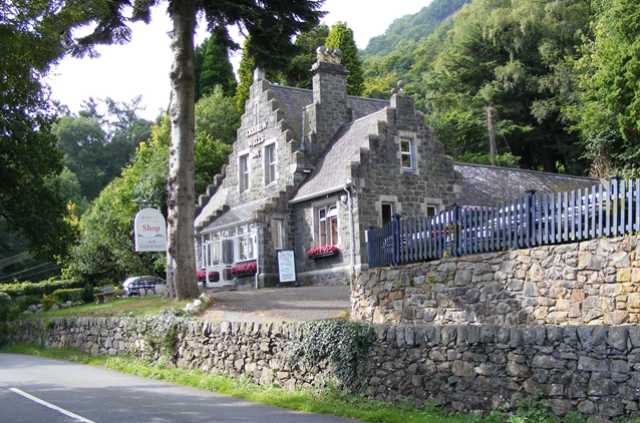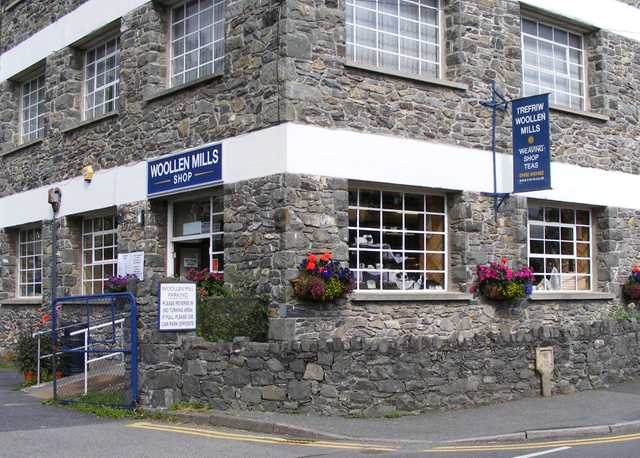[Llandudno HOME] [Deganwy Quay] [Sychnant] [Bodnant] [Great Orme] [Caernarfon] [Tramway] [Excursions] [Links]
Through the Conwy & Lledr Valleys
to Blaenau Ffestiniog & Porthmadog
Part
1 - The Conwy Valley [Part 2 -
Betws-y-coed] [Part 3 - The Lledr
Valley]
[Part 4 -
Vale of Ffestiniog]
The broad glacial
valley of the River Conwy rises in Llyn Conwy near Ysbyty Ifan in the
eastern foothills of Snowdonia. The Conwy is joined near Betws-y-coed
by
two major tributaries. The River Llugwy rises on the southern slopes of
Carnedd Llewellyn and flows via the Nant Ffrancon Pass, through Capel
Curig and over the Swallow Falls. The beautiful valley of the River
Lledr, which rises near Roman Bridge at the foot of the notable Crimea
Pass road, first built by Russian soldiers taken prisoner in the
Crimean War,
continues the route of the A470 trunk road from Llandudno through the
Conwy and Lledr valleys to Blaenau
Ffestiniog and southwards to
Cardiff. The Conwy Valley
Railway line follows the same route
southwards to Roman Bridge from where the longest single track railway
tunnel in the United Kingdom runs two miles through the slate mountain
to Blaenau Ffestiniog. At Blaenau, the railway from Llandudno is joined
by the narrow gauge Ffestiniog
Railway, which continues the passenger
route southwards to Porthmadog. From Llandudno to Blaenau is 31 miles
and from Blaenau to Porthmadog 14 miles.
Both A470 road and
the railway follow the Conwy Valley floor on the eastern side of the
river from Llandudno Junction through Glan Conwy, Tal-y-cafn, Maenan
and Llanrwst to Betws-y-coed. Above is a modern residential area
of Llansantffraid Glan Conwy (to give the village its full title) with
superb views across the river. Below, swans in their natural
habitat were photographed from the Glan Conwy station platform and
between Llandudno Junction and Glan Conwy is the RSPB
Conwy bird sanctuary.
A little further
south and high above the valley floor is the world famous Bodnant
Garden owned by the National Trust and seen below. Please visit my
Bodnant webpages.
Glan Conwy and Bodnant Garden are both served by the
Arriva bus service from Llandudno to Eglwsbach (Service 25 from the
Palladium at 9:20am and every hour until 17:20pm).
On the river, two
miles from the Bodnant Garden entrance is Tal-y-cafn with its old
coaching inn and formerly a ferry crossing on the old drover's road
(now a popular mountain footpath) from Anglesey via Abergwyngregyn,
Bwlchyddeufaen and Rowen, which was formerly a Roman road on the route
of prehistoric tracks from their permanent fort at Caerhun on the
western bank of the river near the ferry, which was itself replaced in
1897 by the present road bridge.
The side roads to
the right and left form the ancient route, which to the left crosses
the railway and then the river bridge. This ancient ferry crossing is
the first crossing of the river after Conwy itself with famous bridges
on the site of an ancient ferry.
Tal-y-cafn still has a manned road crossing gate.
The redeveloped
residential site of the former Ferryboat Inn on the western bank.
Beyond here at Ty'n-y-groes, the road from Tal-y-cafn joins the B5106
road from Conwy through Tal-y-bont, Dolgarrog and Trefriw to
Betws-y-Coed. Arriva operate a bus service every half hour from
Llandudno to Llanrwst via Conwy, Rowen, Tal-y-bont,
Dolgarrog and Trefriw.
A fine pub on the western side of the river between Conwy and Tal-y-Bont "Y Bedol" "The Horseshoe"
Nearby and photographed from the bridge, a swan's nest in its natural habitat.
The railway
continues south from Tal-y-cafn on the eastern bank of the river
through Maenan (where there is a station called Dolgarrog to serve that
township by way of a footbridge and pathway) and onwards to Llanrwst
North,
which is the original station for the market town of Llanrwst.
Llanrwst in 1276 was seized by Llewellyn ap Gruffydd, Prince of
Wales, declaring it a "free borough"
independent from the diocese of St. Asaph to which tithes were formerly
paid. Llanrwst developed significantly following the
establishment of the English fortress at Conwy by Edward I in 1283-9
when Llanrwst was ideally placed for a
free Welsh market conveniently able to trade with the Conwy garrison.
This elegant
suspension
footbridge, the Gower bridge, links by local footpaths Llanrwst North
station (at one time called Llanrwst and Trefriw) with the
village community of Trefriw,
where the Romans had established a
spa with hot baths to serve its garrisons in North Wales. The
Victorians revived the Spa and built this fine fountain head where
hydrotherapy can still be sampled:

The Victorian Spa at Trefriw on the site of the Roman baths.

The Trefriw Woolen Mills, one of the finest surviving tweed mills in Wales, very popular with visitors.
The Victorian Spa at Trefriw on the site of the Roman baths.
The Trefriw Woolen Mills, one of the finest surviving tweed mills in Wales, very popular with visitors.
The tranquil River Conwy near Trefriw.
This famous narrow
three arch stone bridge, Pont Fawr, dating from 1636 was built by Sir
John Wynn of Gwydr Castle reputedly to the design of
Inigo Jones. The bridge connects Llanrwst with Gwydr, a manor house
dating from 1492, and connects with the west bank road from Conwy to
Betws-y-coed. It is on the site of
an ancient ford and possibly also an earlier bridge. It is still the
only road crossing of the river between Tal-y-cafn and Betws-y-Coed.
Tu Hwnt i'r Bont the 15th century Court House over the bridge from Llanrwst is in the care of the National Trust and currently let for use as popular tea rooms.
The thirteenth
century church at Llanrwst commemorates St Grwst, the seventh century
founder of an earlier church on this site. Other property of interest
in this ancient Welsh town include The Almshouses built by Sir John
Wynn in 1610.
Continue southwards from Llanrwst by train, by A470 road or across the bridge and south on the B5106 road past the Gwydr estate. Both roads and the train lead to Betws-y-coed - click the Part 2 link below.
Continue southwards from Llanrwst by train, by A470 road or across the bridge and south on the B5106 road past the Gwydr estate. Both roads and the train lead to Betws-y-coed - click the Part 2 link below.
Photographs © 2004/7 by Noel Walley. Updated December 2008
Email: Webmaster
Conwy & North Wales